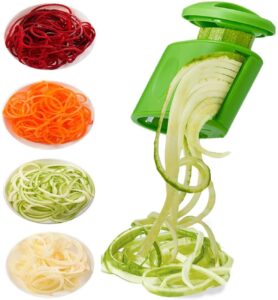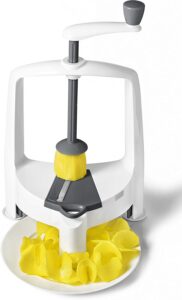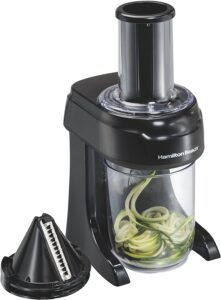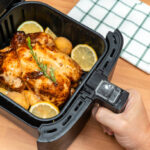Food spiralizers or spiral slicers originated from the very creative Japanese cousin. However, this kitchen tool became incredibly popular in western kitchens only in recent years. Vegetable spiral slicers make creatively shaped vegetables and fruits to use for salads, vegetable spaghetti, pasta, nicely shaped potato chips, and colorful vegetable noodles.
Spiralizers allow you to cut carbohydrates and instead get more vegetable and fruit salads into your diet, which are more nutritious. This trend greatly enriched today’s home and commercial kitchen because it has dramatically simplified the preparation of healthy and artistic-looking recipes.
Read More: Vitamix Classic Containers Guide | KitchenGearPro
Disclosure: As an Amazon Associate, we may earn an affiliate commission for purchases you make when using the links on this page.
Table of Contents
What is a Vegetable Spiralizer, and What Does It Do?
A vegetable spiralizer is a kitchen appliance designed to cut vegetables and fruits into long ribbons, strips resembling noodles, spaghetti, or spirals changing them into pasta and noodles of various sizes, lengths, and stands. Also, it is an excellent tool for making an elegant dish of salad. The gadget can efficiently work on firm vegetables and fruits such as zucchini, carrots, beetroots, celery root, cucumbers, onions, cabbage, apples, and others.
There are three types of spiralizers, namely: handheld, manually crank, and electric spiralizers.
Handheld Spiralizers

It has no handle to turn the vegetables as you crank, so one has to manually twist the veggie through the blades. You are holding the machine with your left hand and the veggie in your right hand. Twist it through into the machine to make your noodles.
Notably, a handheld spiralizer can handle only a limited selection of vegetables. It cranks taller or thinner pencil-like vegetables such as carrots, cucumbers, zucchini, mooli, daikon, etc. Large vegetables need to be cut to fit.
Besides, this kitchen device is suitable for preparing small quantities of spiralizer veggies. They may also require more effort to spiralize hard or wider fruits and vegetables and produce more significant amounts of waste products. Moreover, there is some chance to injure yourself as one uses this machine.
However, you should again not worry much about its cost, for it costs approximately $5 — $10. This price is reasonably lower than other types of spiralizers.
Pros:
- The spiralizer is affordable;
- Takes little storage space;
- It is appropriate when making small quantities of vegetable noodles.
Cons:
- The spiralizer handles a limited type of ingredients;
- It is tiresome to use;
- Hardly can make large quantities of vegetable noodles;
Manually Crank Spiralizers
A manually cranked spiralizer is a kitchen machine that enables you to process the vegetable or fruit by manually turning the handle. This type of spiralizers is very easy to use and handles the broadest range of ingredients among all kinds of spiralizers.
It usually comes with a set of interchangeable blades of 2.5mm‑3 mm for making noodles and 4mm-5mm for making curly potato fries. Some spiralizers include 1mm‑1.5mm blades for making angel hair noodles from firm ingredients like carrots or radish.
Notably, there are two types of hand-crank spiralizers, vertical, which positions vegetables and fruits vertically, and horizontal, those that place the vegetable (or fruit) horizontally.
Horizontal Manual Crank Spiralizer

Furthermore, the manually crank spiralizer is safe to use; however, they leave some waste, such as unprocessed core parts that are located around the fixing spike. The horizontal vegetable spiralizers cost approximately $25 — $180 depending on the models, the Chinese version is the cheapest, and the original Japanese may cost as much as $180.
Pros:
- Process a wide variety of veggies and fruits;
- Come with blade selection for different noodles and pasta types;
- Very easy to use;
- Safe to process ingredients;
Cons:
- Leaves behind some unprocessed vegetables typically;
- Some models do not handle firm ingredients well.
Vertical Manual Crank Spiralizer

The same as horizontal machines, vertical is very easy to operate and able to process a wide range of ingredients from the soft zucchini and cucumber to firm sweet potatoes and butternut squash. More so, with this type of spiralizer, there is no wasted “core” left because the vegetables are fixed in a vertical position.
The device is also affordable and priced in the same range as horizontal devices; however, the USA market does not have a large variety of vertical spiralizer as the European market offers.
Pros:
- Process a wide range of ingredients;
- Needs little effort when spiralizing veggies compared to horizontal spiralizers;
- It comes with an exchangeable selection of blades;
- Leaves less wastage than horizontal devices;
Cons:
- Are not widely present in the USA market.
Electric Spiralizers

However, electric spiral vegetable slicers are not as versatile as manual cranked devices, and they are not able to process thick-diameter ingredients such as onion or cabbage. These devices usually come with 3 inches a diameter feeding chute, and thicker vegetables must be precut before processing. Moreover, such firm ingredients as butternut squash will require extra effort to cut into the proper size to fit into the chute.
Furthermore, electric spiralizers are usually more expensive than manual devices, ranging from $50 to $150.
Pros:
- Suitable for those who require to handle loads of veggies
- Spiralizes without straining; no physical effort is needed for its operation;
- It comes with a variety of blades for different types of noodles and pasta;
- The device saves your time when preparing noodles;
Cons:
- Does not handle a wide variety of ingredients;
- May need precutting for some thicker vegetables.
What Spiralizer‘s Accessories and Feature May Be Important?
Blades: Upon purchase, you need to check the number of blades a spiralizer has and what you can use them for. The typical spiralizer will usually include the noodle size blade of 2.5mm‑3 mm, the spiral size blade of 4mm-5mm, some include angel hair noodles blades of 1mm‑1.5mm, and a few have additional cutting blades for making long ribbons.
Blade Storage Container: Consider a spiralizer with a blade storage container. Whether the blade storage is plastic or metallic, it needs to be large, secure, and tough enough to hold the steel blades without being torn or being too small for the edges.
Suction Feet: Consider a spiral vegetable slicer with suction feet when buying a cheaper model. Although the original Japanese devices are constructed to operate without the suction feet, the Chinese knockoffs will definitely require them for efficient operation.
Final Thought
Spiralizers are special kitchen devices that can change our diet. They help us flavor our meals by making tasty pasta, salads, potato chips, colorful, spaghetti-like vegetable noodles, etc. Do you want to make your family healthier? You need to go for a manual, electric, or handheld spiralizer, depending on the purpose of the device. If you need to spiralizer regularly, then you need to own an electric one or good quality manual crank spiralizer. You need to purchase a handheld spiralizer if you don’t intend to spiralize frequently. Get a spiralizer according to your specifications and enjoy meals after that.



